Forex traders approach the market from different perspectives. Some expect quick and very fast profits. This is scalp trading. Others, invest. They have a different time horizon in mind. As such, scalp trading strategies simply won’t fit their personality.
Retail traders love scalping. They like the idea of making a quick profit.
If you come to think of it, scalp trading reflects human nature at its best. As humans, we don’t like to wait long for something.
Like in life, we grow impatient easily. And, when it comes to money, we have even less patience.
It doesn’t mean scalp trading strategies won’t work. They do, and, most of the times, they have a bigger success ratio than other strategies.
However, they come with some costs. For example, sticking in front of the screens all day.
In any case, scalp trading is a way to approach the Forex market. For most of the retail traders, it is the preferred way.
Retail traders don’t dedicate their entire time to trading. Most of them have day jobs, and so on.
Therefore, in their free time, they scalp for small profits. I mean, what’s wrong with supplementing your income with a trade here and there?
However, make sure you understand what scalp trading is and how to approach it. In this article, we’ll cover:
- What is scalp trading?
- Different scalp trading strategies
- How to build a scalp trading system
- Reasons for scalp trading
- Cons of scalp trading
The main idea is to show the best ways to scalp trading. And, to demonstrate the advantages of scalp trading strategies over other ones.
What Is Scalp Trading?
If you open and close a trade fast, you either:
- Made a wrong call and just realized it
- You’re a scalp trader
A scalp trader has many great traits. Just to mention a few, he/she:
- Likes to act fast in a fast-paced environment
- Doesn’t mind spending hours in front of the trading platform
- Grabs tiny amounts of pips, but, multiple times during the trading day
- Doesn’t like to pay swaps
Patience doesn’t fit the bill. Why wait for a hundred pips move, when you can grab them in small trades?
As we all know, the market doesn’t always move. In fact, most of the times it ranges.
Statistically, prices stay more in range than in a trend. Therefore, scalp trading strategies make sense.
A scalp trader uses smaller time frames. But not only.
For example, if the market reaches an important Fibonacci level on the daily time frame, a scalp Forex trader may buy/sell around it. However, in doing that, it’ll go on the lower time frames to pick the actual entry.
A scalp trading Forex system is born on lower time frames. In fact, the lower the time frame, the better.
Scalp traders love a fast-paced trading environment. As such, it is no wonder they go down even to the one-minute period.
Traders involved in scalp trading don’t keep positions overnight. Therefore, they don’t worry if a currency pair carries a negative swap.
What they care about is the spread. Hence, the lower the spread, the better.
Why? Because the spread is the only cost associated with scalp trading strategies.
How to Scalp Forex Currency Pairs
Traders buy and sell a currency pair for various reasons. A scalper will make multiple trades per day, with the number varying based on how the market moves.
Or, based on its volatility. As such, scalp trading strategies work on currency pairs that move a lot. And, have a lower spread.
Picking the right broker for scalp trading is essential. Results will vary widely, as brokers will impact scalp trading.
Technical Scalp Trading
Most scalp traders use technical analysis. And, they apply their scalp trading strategies on lower time frames.
Apparently, they want to buy in oversold levels. And, sell, when price moves in overbought territory.
How to do that? Well, oscillators come to save the day.
But, as we know by now, trading with oscillators is tricky. They work if the price stays in range.
Therefore, scalp trading strategies based on technical analysis require a range. Or, a period when the overall market ranges. Even better, when traders expect a range.
Typically, the Asian session is best for trading overbought and oversold levels. Even on the lower time frames.
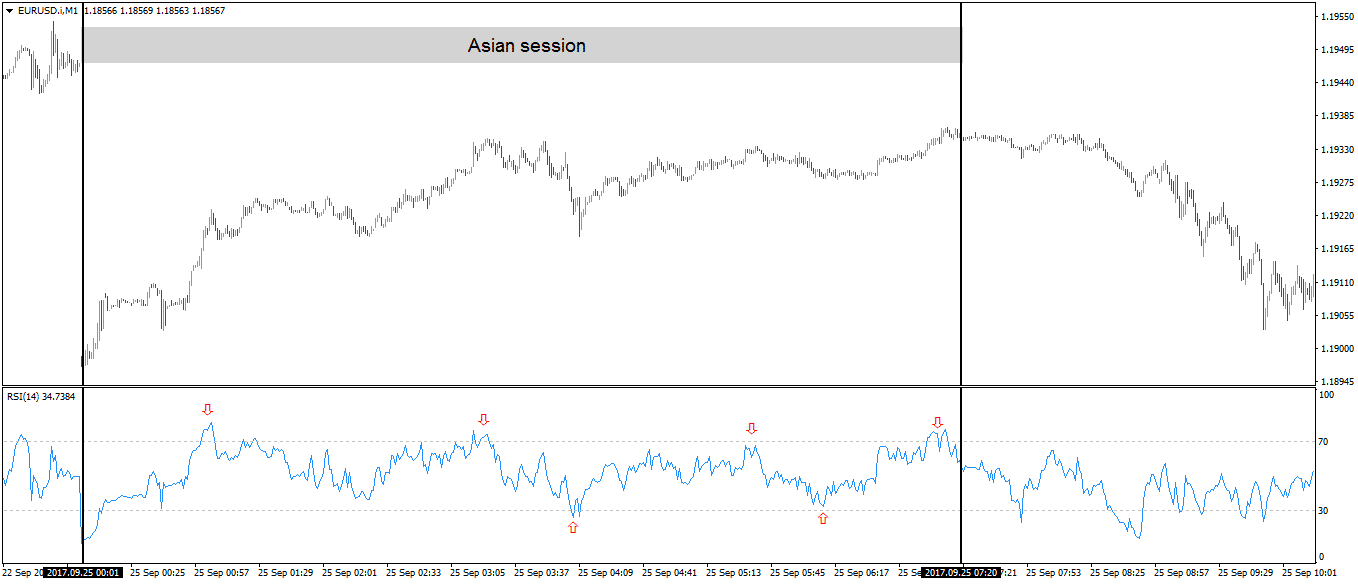
Above is the EURUSD one-minute chart. It shows the previous Asian session. Moreover, it has the RSI (Relative Strength Index) attached.
It offered five entries in either overbought or oversold territory. The idea is to enter and wait until the RSI reaches the opposite level.
Because the time frame is so small, you’ll get a chance to trade multiple times. Otherwise, that’s scalp trading.
But it isn’t limited to the Asian session. In fact, anytime traders define a range, scalp trading strategies work. Or, they have better chances to work.
For instance, consider the NFP (Non-Farm Payrolls) week. Typically, the Forex market holds a range all week until Friday’s release.
Hence, you can define a range. Next, you apply scalp trading strategies.
Scalp Trading the News
A trader’s objective is to make money. That’s the basis of speculation.
A scalp trader’s primary objective is to make money fast. And, as much as possible.
Some days may offer ten opportunities to scalp. Or, on other days, more trades appear.
But, for opportunities to rise, the market must move. The faster, the better.
However, the market mainly moves on the news. Hence, scalp trading the news is a way to make a living as a retail trader.
Scalp traders do have a trading plan. Scalp trading strategies consider money management too.
For example, a scalp trader may stop trading after reaching several pips. Let’s say, fifty pips per day.
When the market moves, it may take less than half an hour. If it doesn’t, it may take the whole day.
Moreover, the pips target may not even come. If there’s no news, the market will naturally range.
Scalp trading the news mainly means to trade in the same market direction.
Therefore, traders wait for the news to come out. Next, they wait for the initial market reaction.
Furthermore, look for a pullback. Finally, enter a trade in the same direction given by the news.
Of course, they buy/sell at support/resistance. Or, when an oscillator comes in overbought/oversold areas on lower time frames.
Scalp Trading Strategies That Work – News Trading Example
Here’s a case on the EURUSD pair and how to scalp trading the news. However, this is a bigger time frame: the five-minute one.
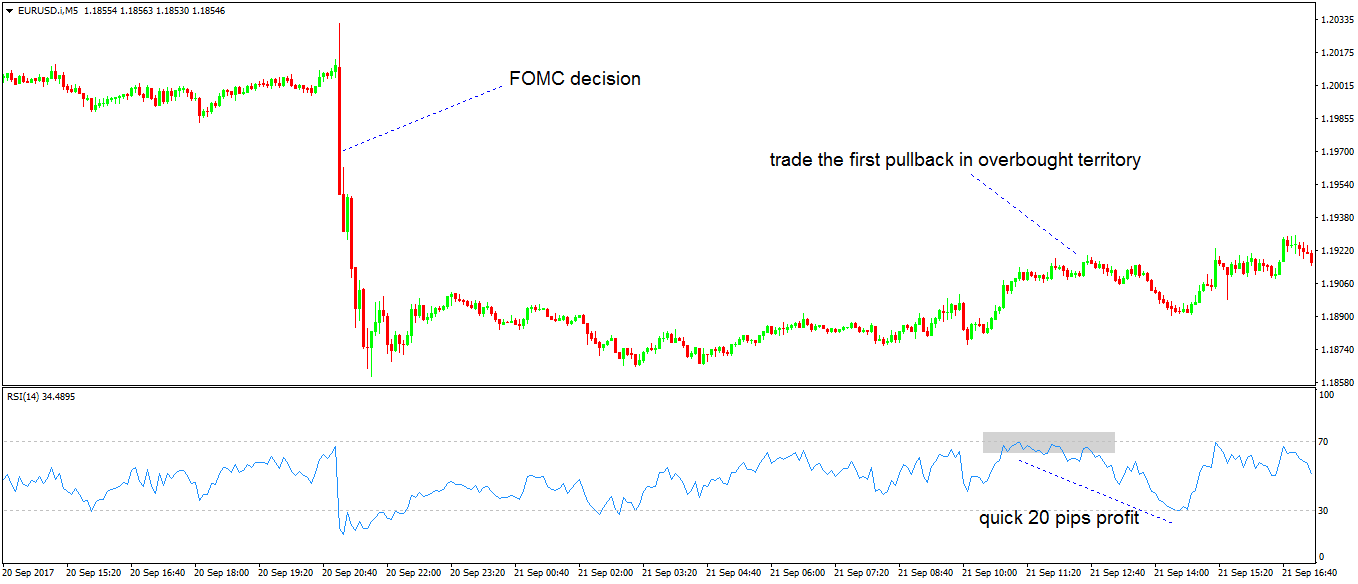
The big, red candle is the market reaction to the last FOMC (Federal Open Market Committee) decision. This is one of the most important events on the economic calendar.
A scalp trader won’t trade the news directly. Or, a SMART one won’t do that.
Instead, he/she will wait for a pullback. The market direction is as clear as the light of day: bearish.
As such, traders involved in scalp trading wait for a pullback. They use an oscillator like the RSI. And, they sell a withdrawal in overbought territory.
The moment it came, it was a quick twenty pips profit, from overbought to oversold levels. Such scalp trading strategies combine news trading with technical analysis.
But, at the end, who cares what the reasoning was? The idea was brilliant, and it made money.
Moving forward, the more the oscillator comes back in overbought territory, the weaker the first trend becomes. Hence, scalp trading becomes riskier.
Scalp Trading Strategies with Different Indicators
So far, we showed how to scalp trading with the RSI. It is the favorite choice among retail traders.
However, it is not the only oscillator that works in scalp trading. Any oscillator does.
Any oscillator shows overbought and oversold levels. Or, at least potential ones.
Therefore, just apply them on the lower time frame and look for a market reaction. But, beware of the trading environment. It must range.
Scalp Trading with Stochastics
Trading with Stochastics perfectly illustrates scalp trading. There’s a reason for that.
In sharp contrast with other indicators, the Stochastics oscillator moves fast. Or, faster.
It reaches overbought and oversold levels faster than other oscillators do. For example, faster than the RSI.
It is a great tool for scalp trading. A source of potential gains from these quick moves.
But, some conditions must exist first. As such:
- The market is expected to range
- The currency pair is volatile enough
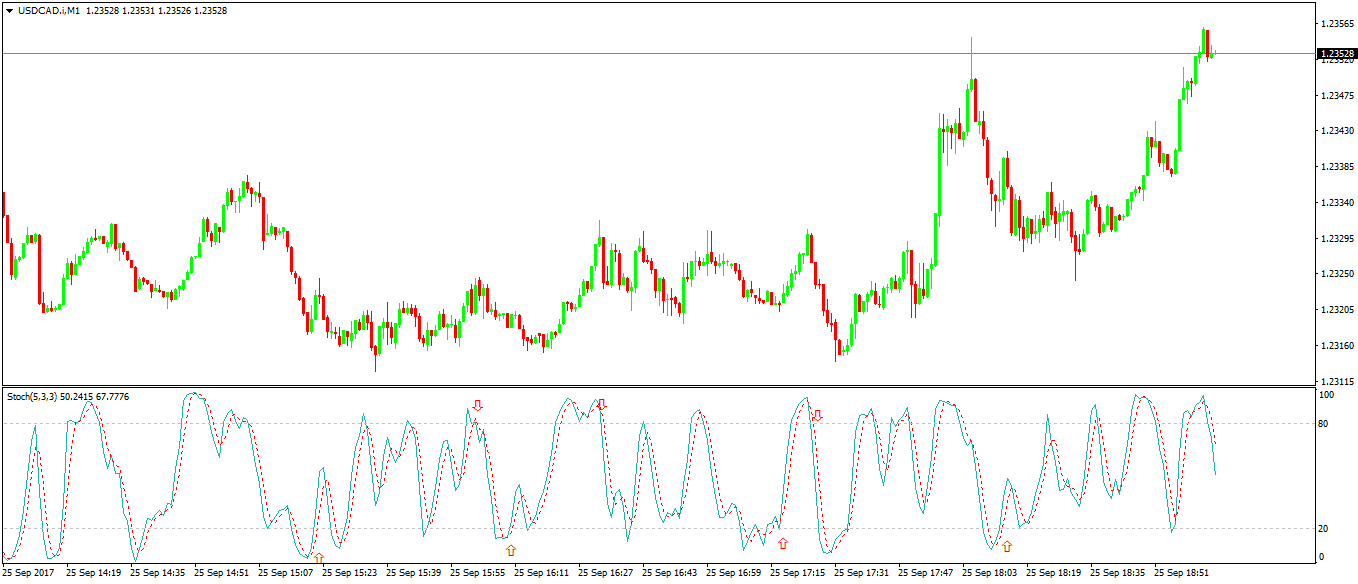
Here’s the USDCAD one-minute time frame. It shows the current price action.
Today is a Monday. Typically, the market is slow on Mondays.
Moreover, it is a bank holiday. It means the main drivers for the market miss from the picture.
Hence, the chances are that the market will range. By range, it means it’ll move, but keep a median level in the end.
Therefore, the market fits the first condition. Plus, the USDCAD is a major pair. It has decent volatility for scalp trading.
The Stochastics oscillator gave excellent entries. Scalp trading strategies like this one must:
- Wait for Stochastics to reach overbought or oversold levels
- Wait for the signal line to cross the main one
- Take a trade when the signal line exits the overbought/oversold levels
But scalp trading doesn’t work only with oscillators. It works with trend indicators too.
Scalp Trading with the Bollinger Bands Indicator
The Bollinger Bands indicator shows trending conditions. That is, most of the times.
However, it is a great scalper indicator. It allows traders to go with the trend. And, scalping their way out of it.
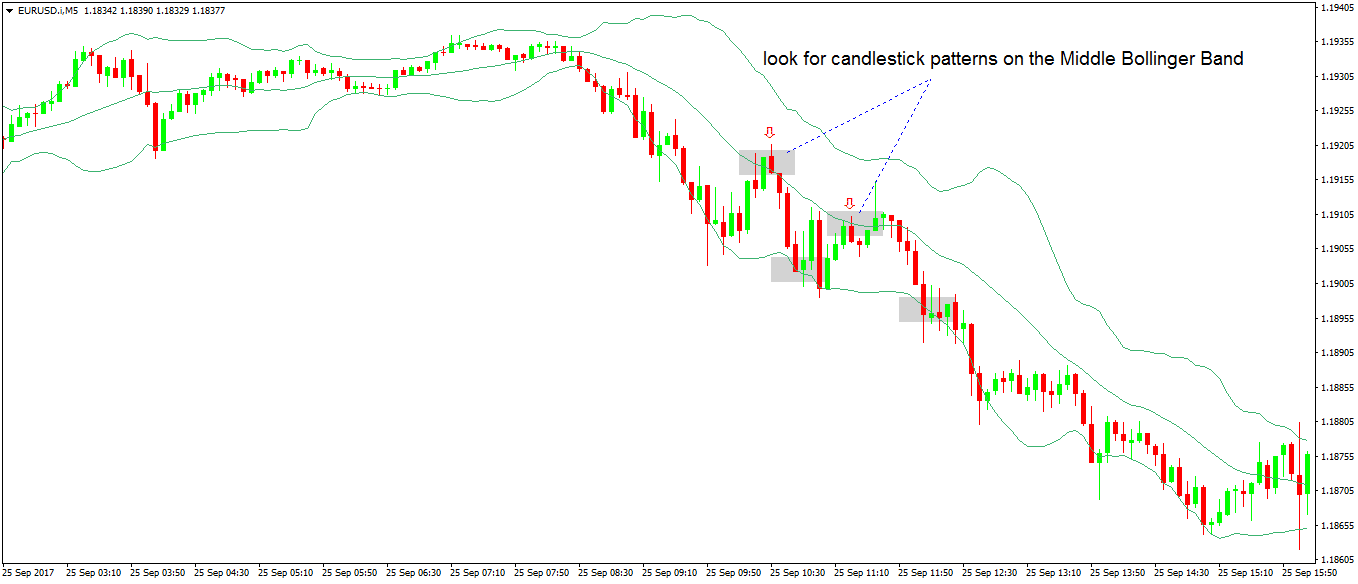
The idea is to know when to enter. And, when to exit.
After all, this is what trading is: planning a trade and executing it.
Scalp trading with Bollinger Bands requires several steps. First, wait for the market to stay in the lower or upper part of the Bollinger Bands indicator.
Second, wait for a pullback to the MBL (Middle Bollinger Band). Third, look for some candlestick reversal patterns to form there:
- Doji candles
- Engulfing patterns
- Piercing or dark-cloud cover
- Stars, etc.
Finally, trade in the trend’s direction, targeting the LBB (Lower Bollinger Band). The earlier chart illustrates why such scalp trading strategies work.
In fact, this is how the umbrella concept works. Let me explain it in more detail below.
The Umbrella Concept in Scalp Trading
A blend between swing trading and scalping, the umbrella concept is a fantastic approach to trading. It starts from a longer-term trade.
As such, traders buy or sell a currency pair for a different reason. And, on a bigger time frame.
It could be that the Elliott Waves count calls for a bullish move on the hourly chart. But, it could take days to unfold.
Moreover, an impulsive wave has its pullbacks. Why not use them?
Therefore, traders take the first trade; the Elliott Waves derived one.
Next, they go on the lower time frames. Five-minute and one-minute ones work best.
Finally, they start scalp trading on these time frames. But, only on the direction of the central Elliott Waves trade.
Below is the daily USDCAD time frame. It shows a completed five-wave structure.
However, traders knew before-hand it would form. The blue b-wave was part of a flat pattern.
Hence, the c-wave of a flat follows. And, that’s always an impulsive wave.
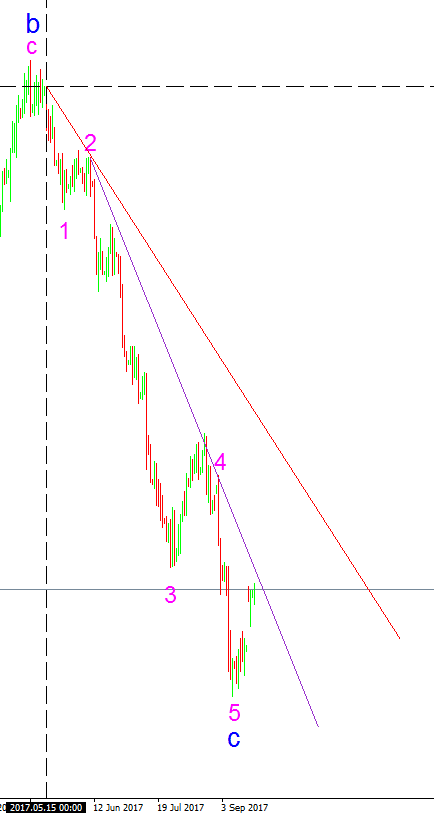
And, the impulsive wave started on May fifteen, 2017. That’s long enough even for swing trading.
Until the impulsive wave ends, scalp trading strategies work on lower time frames. That is scalp trading strategies only to short the pair.
The hourly chart works best here. There is quite a difference between the daily and hourly time frames.
Traders simply use oscillators to scalp their way on the short side. Always, on the short side, until the trade on the bigger time frame ends.
By taking trades in the same direction, the scalp trading ones are under the umbrella of a different argument. Or, in this case, a different trade.
Pros and Cons of Scalp Trading
The main reason to scalp trade is that smaller moves are easier to catch. They happen more often, and so the chances to make a profit increase.
On top of this, scalp trading is cheaper. That is, cheaper than investing. Or, swing trading.
As a scalper, your only worry is the spread. Of course, the lower, the better.
So, make sure you know the spreads the broker offers, before opening a trading account. Your scalp trading strategies depend on it.
On the opposite side, scalp trading requires cutting-edge execution. That’s difficult to get in today’s market environment.
When news comes out, the market flies. And so does your stop loss or take profit.
Slippage accounts for one of the leading scalp trading issues. For example, imagine you have a ten pips profit trading strategy.
That is, you always target ten pips in a trade. After ten trades, you’re up one hundred pips. And, the market may not even move in the meantime. You made money.
But, here comes slippage. Assuming you have a stop loss (you must have one!), if it gets hit during news releases, the execution won’t be perfect.
Any ECN (Electronic Communication Network) or STP (Straight Through Protocol) trading account will execute the order at the market. Or, when there is a market.
If the market moves too fast, your order gets executed where the market is. If it is only one pip further, it represents ten percent of your potential gain. That’s quite a high cost to account for.
Conclusion
Like any trading style, scalp trading has its advantages and disadvantages. For some, it is the best way to approach the Forex market.
Others find it impossible to use. They simply may not have the time for it.
As always, the Forex market has something for everyone. But all types of traders must respect the market.
They have a money management system. And, they follow it no matter what.
Scalp trading strategies integrate risk-reward ratios with difficulty. When your target is ten pips, what should be the stop? Five?
For the Forex market, that’s too little. A currency pair moves five pips in a blink of an eye. With no news in sight, whatsoever.
From this perspective, scalp trading is riskier than other styles. In a way, it is a desperate move traders do to gain some.
If volatility is not an issue, everyone will trade with the trend. But, when the market doesn’t move on the bigger time frames, traders go down to smaller ones.
When you trade for a living, you got to make it day in, day out. Bills come at the end of the month, no matter if the market moved or not.
As such, a complete professional retail trader will have something from all styles. He/she will invest, swing trade, or scalp the market to make a profit.
After all, you must take what the market gives. Sometimes only scalp trading works. Other times, swing trading works best.
No hard feelings. No nothing. Just the desire to make it day in, day out.
